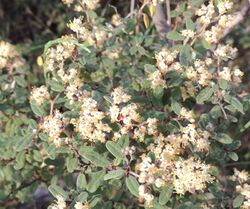Biology:Pomaderris pallida
| Pomaderris pallida | |
|---|---|

| |
| In Pine Island Reserve | |
| Scientific classification | |
| Kingdom: | Plantae |
| Clade: | Tracheophytes |
| Clade: | Angiosperms |
| Clade: | Eudicots |
| Clade: | Rosids |
| Order: | Rosales |
| Family: | Rhamnaceae |
| Genus: | Pomaderris |
| Species: | P. pallida
|
| Binomial name | |
| Pomaderris pallida N.A.Wakef.[1]
| |
Pomaderris pallida, commonly known as pale pomaderris,[2] is a species of flowering plant in the family Rhamnaceae and is endemic to the south-east of continental Australia. It is a compact, rounded shrub with hairy stems, narrowly elliptic to narrowly oblong leaves and panicles of cream-coloured flowers.
Description
Pomaderris pallida is a compact, rounded shrub that typically grows to a height of 1–2 m (3 ft 3 in–6 ft 7 in), its stems covered with small woolly, whitish, star-shaped hairs. The leaves are narrowly elliptic to narrowly oblong, 8–20 mm (0.31–0.79 in) long and 3–6 mm (0.12–0.24 in) wide, both surfaces densely covered with velvety, star-shaped hairs. The flowers are borne in small, leafy panicles 20–80 mm (0.79–3.15 in) long with five cream-coloured, petal-like sepals but there are no petals. Flowering occurs from September to December and the fruit is a hairy capsule.[2][3][4]
Taxonomy
Pomaderris pallida was first formally described in 1951 by Norman Arthur Wakefield in The Victorian Naturalist from specimens collected by Richard Hind Cambage near the junction of the Murrumbidgee and Cotter Rivers in 1911.[5][6] The specific epithet (pallida) means "pale".[7]
Distribution and habitat
This pomaderris grows in open forest and scrub in woodland but is only known from a few populations in the Australian Capital Territory and south-eastern New South Wales.[2][3][8]
Conservation status
Pomaderris pallida is list as "vulnerable" under the Australian Government Environment Protection and Biodiversity Conservation Act 1999 and the New South Wales Government Biodiversity Conservation Act 2016.[2][3][8]
References
- ↑ "Pomaderris pallida". Australian Plant Census. https://biodiversity.org.au/nsl/services/apc-format/display/112326. Retrieved 26 March 2022.
- ↑ 2.0 2.1 2.2 2.3 Harden, Gwen J.. "Pomaderris pallida". Royal Botanic Garden Sydney. https://plantnet.rbgsyd.nsw.gov.au/cgi-bin/NSWfl.pl?page=nswfl&lvl=sp&name=Pomaderris~pallida.
- ↑ 3.0 3.1 3.2 "Pale pomaderris - profile". New South Wales Government Office of Environment and Heritage. https://www.environment.nsw.gov.au/threatenedspeciesapp/profile.aspx?id=10653.
- ↑ Wood, Betty. "Pomaderris pallida". Lucid Keys. https://apps.lucidcentral.org/plants_se_nsw/text/entities/pomaderris_pallida.htm.
- ↑ "Pomaderris pallida". Australian Plant Name Index. https://biodiversity.org.au/nsl/services/rest/instance/apni/545279. Retrieved 26 March 2022.
- ↑ Wakefield, Norman A. (1951). "New species of Pomaderris.". The Victorian Naturalist 68 (8): 141–143. https://www.biodiversitylibrary.org/item/127325#page/153/mode/1up. Retrieved 26 March 2022.
- ↑ Sharr, Francis Aubi; George, Alex (2019). Western Australian Plant Names and Their Meanings (3rd ed.). Kardinya, WA: Four Gables Press. p. 269. ISBN 9780958034180.
- ↑ 8.0 8.1 "Approved Conservation Advice for Pomaderris pallida". Australian Government Department of Primary Industries, Water and the Environment. https://www.environment.gov.au/biodiversity/threatened/species/pubs/13684-conservation-advice.pdf.
Wikidata ☰ Q17252160 entry
 |


